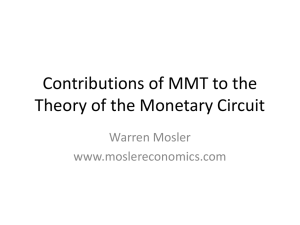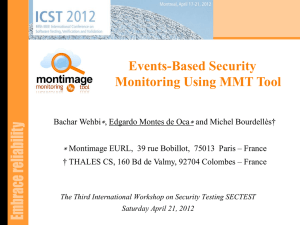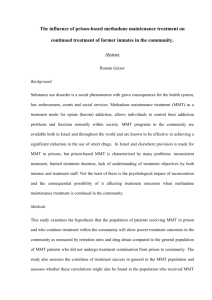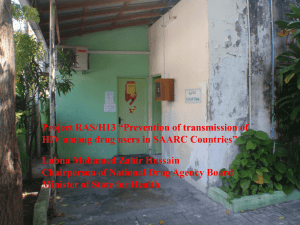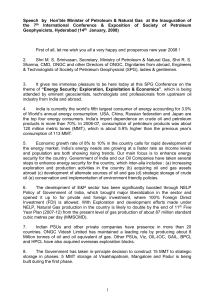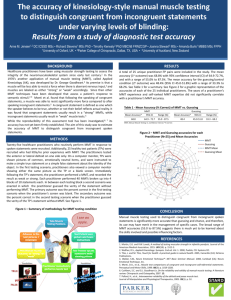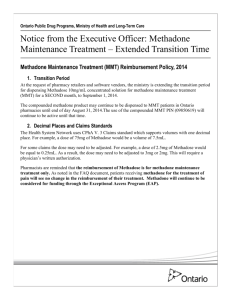MMT Initiative Guide v2.0
advertisement
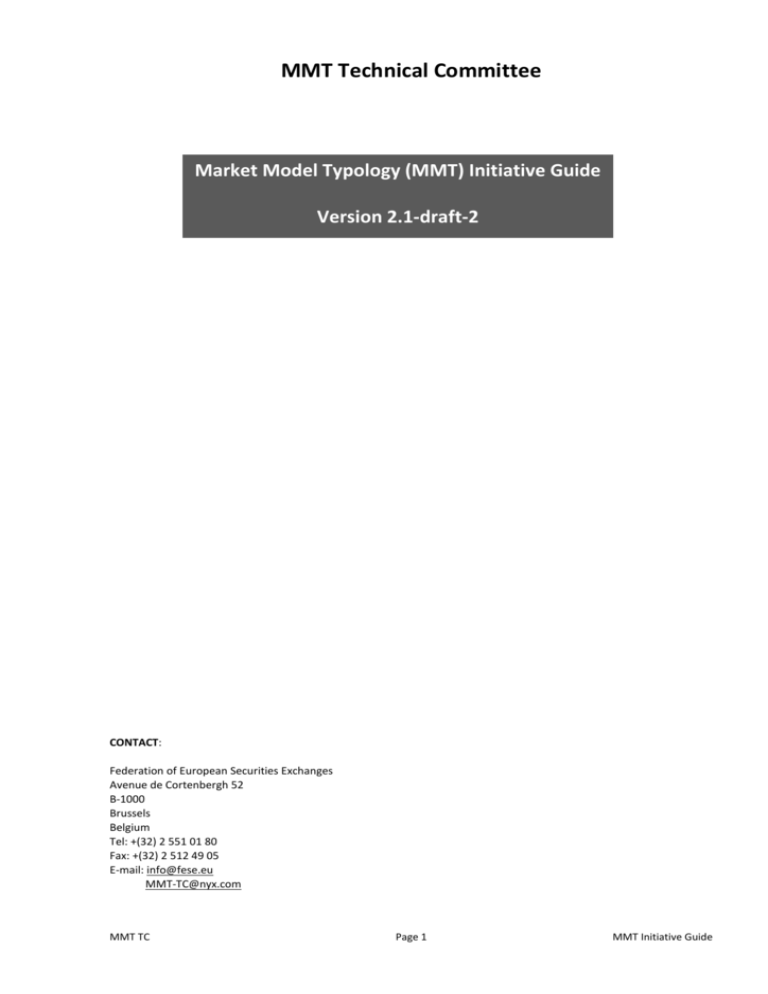
MMT Technical Committee Market Model Typology (MMT) Initiative Guide Version 2.1-draft-2 CONTACT: Federation of European Securities Exchanges Avenue de Cortenbergh 52 B-1000 Brussels Belgium Tel: +(32) 2 551 01 80 Fax: +(32) 2 512 49 05 E-mail: info@fese.eu MMT-TC@nyx.com MMT TC Page 1 MMT Initiative Guide MMT Technical Committee CHANGE HISTORY Version Date of Change Description of Change 1.0 2.0 Sept, 2011 May, 2012 2.1-draft-1 2.1-draft-2 Feb, 2013 First published draft – Removed section on MMT Governance – Updated definition of ‘Technical Trade’ in Section 6.1.3 and the Glossary – Minor edits throughout – Updated formatting Updated to reflect v2 of the MMT Matrix Updated section 6.1.3 to remove “Technical Trade” from “Trade with Conditions” ADDITIONAL DOCUMENTATION The following additional documentation is available from the MMT Technical Committee (MMT TC): • MMT Initiative Trade Flag Mapping Guide • MMT Initiative FAQ • MMT Initiative Mapping Matrix MMT TC Page 2 MMT Initiative Guide MMT Technical Committee Contents 1. Document Scope........................................................................................................ 4 2. The MMT Initiative .................................................................................................... 4 3. MMT Stakeholders..................................................................................................... 5 4. MMT Implementation ................................................................................................ 5 5. MMT Documents ....................................................................................................... 5 6. MMT Matrix .............................................................................................................. 7 6.1 6.2 7. Data Structure and Data Hierarchy ........................................................................................... 7 6.1.1 Level 1: Market Mechanism ........................................................................................ 8 6.1.2 Level 2: Trading Mode ................................................................................................ 8 6.1.3 Level 3: Transaction Type ........................................................................................... 9 6.1.4 Level 4: Publication Mode......................................................................................... 11 Fully Embedded ESMA/CESR Recommendations ...................................................................... 11 MMT Syntax and Encoding ........................................................................................12 7.1 7.2 7.3 7.4 General Remarks ................................................................................................................... 12 Physical Field Codes............................................................................................................... 12 Mandatory Requirements ...................................................................................................... 12 Completing the MMT Questionnaire ....................................................................................... 12 8. Conditions of Use of MMT .........................................................................................13 9. Glossary ...................................................................................................................13 MMT TC Page 3 MMT Initiative Guide MMT TECHNICAL COMMITTEE 1. Document Scope The MMT Guide is meant to be used as a support document, together with the MMT Initiative Mapping Matrix, to assist in the completion of the MMT Questionnaire. The MMT Initiative Guide aims to provide clear definitions for the terms used within the MMT Initiative. 2. The MMT Initiative The MMT was developed through the collaborative efforts of exchanges, MTFs, market data vendors and trade reporting venues as a means of standardising post-trade data reporting. Market fragmentation can be seen as a natural by-product of competition but more action is needed to meet the challenges in the area of equity market data, in particular the post-trade transparency. Though much of this stems from an inherent lack of standards in the OTC market, Regulated Markets and MTFs also need to support a single industry standard that can be applied across all sources of post-trade data. Due to the scale and complexity of coordinating the implementation of standard trade conditions across the industry as well as the potential regulatory dependencies for changing existing local market standards, MMT was designed to enable standardisation through abstraction while native adoption of standards can proceed in parallel. In many cases, MMT trade conditions will complement existing proprietary codes rather than replace them. The MMT Initiative is open to all industry participants to support the idea of one standard and has been developed by experienced professionals ranging from equity market operators, reporting venues and data vendors. It is intended that the delivery of the MMT will facilitate the delivery of a European Consolidated Tape regardless of whether it is delivered by a single provider or by multiple providers delivering consistent but competing consolidated tape solutions. MMT TC Page 4 MMT Initiative Guide MMT TECHNICAL COMMITTEE 3. MMT Stakeholders The MMT Initiative is open to all equity market data users across the industry, from data originators (securities exchanges, MTFs, APAs) to end consumers (private investors, fund managers, treasurers, academics), including solution providers (data vendors, ASPs, ISVs, OMS providers). The following group of stakeholders will benefit from MMT implementation: 4. MMT Implementation The implementation of the MMT Initiative is regarded as two distinct achievable goals: MMT Questionnaire and MMT Initiative Trade Flag Mapping Guide: The first step for participation in the MMT Initiative is the completion of the MMT Questionnaire by each participant, which naturally facilitates inclusion in the MMT Initiative Trade Flag Mapping Guide. o The MMT Initiative Trade Flag Mapping Guide is the central document, which will store the information provided in the completed questionnaires and therefore is inclusive of all participants that have completed their MMT Questionnaire. o The MMT Initiative Trade Flag Mapping Guide will be made openly available and can be utilised by parties wishing to apply the mapping to codes within their own data infrastructure. Feed Disseminated MMT Mapping: Participants of the MMT Initiative who have completed the MMT Questionnaire for inclusion in the MMT Initiative Trade Flag Mapping Guide will be encouraged to implement the MMT mapping in their relevant Market Data feeds to allow dissemination within trade reports directly to consuming parties. 5. MMT Documents The following documents are available: MMT TC Page 5 MMT Initiative Guide MMT TECHNICAL COMMITTEE MMT TC MMT Initiative Mapping Matrix: This documents the data structure and hierarchy of the MMT Initiative in a tabular format. It explains the available combinations of attributes that could be applied to any one trade reported by a market operator. The MMT Initiative Mapping Matrix provides a structured model to assist with the completion of MMT Questionnaire. MMT Initiative Guide: This is a support document to the MMT Initiative Mapping Matrix and MMT Questionnaire which provides definitions and methodology. It explains the process for participation, provides definitions for the initiative and explains the structure and hierarchy of the MMT Matrix. MMT Initiative Questionnaire: This is the mapping document to be completed by participants. The information reported in the MMT Questionnaire will be included in the MMT Trade Flag Mapping Guide. MMT Initiative Trade Flag Mapping Guide: The full mapping table containing information from all completed MMT Questionnaires. The MMT Trade Flag Mapping Guide will be made available to all industry participants. MMT Initiative FAQ: A list of the most commonly asked questions. Page 6 MMT Initiative Guide MMT TECHNICAL COMMITTEE 6. MMT Matrix This section explains the structure and hierarchy of the MMT Matrix and provides definitions for the attributes and terms used. 6.1 Data Structure and Data Hierarchy MMT is structured into four primary complementary levels that collectively describe the circumstances under which a trade has been executed. Every trade will carry attributes from each of these levels. MMT TC Page 7 MMT Initiative Guide MMT TECHNICAL COMMITTEE 6.1.1 Level 1: Market Mechanism Level 1 of MMT defines the fundamental functional market mechanism that has facilitated the trade, and it can have one of the following values. They are mutually exclusive. See also details on the MMT Initiative Mapping Matrix document. Level 1: MARKET MECHANISM Meaning Central Limit Order Book A trading mechanism where transparent , iceberg and LIS Hidden buy and sell orders interact on an electronically maintained order book and are prioritised/sorted in order of price and time. Buy and sell orders that match in price are immediately and automatically executed, with the transaction typically also being reported immediately. Quote Driven Market A trading method by which execution prices are largely determined from buy and sell offer quotations issued by market makers or dealers. Most such systems operate a mandatory quotation period during each trading day, during which registered market makers must display their best buy and sell quotations. The market makers are obliged to transact at those quotations if approached to do so. Dark Order Book A dark order book offers the similar or equivalent capabilities to a Central Limit Order Book, but the orders and their attributes are not displayed –orders are completely hidden which grants the traders full anonymity with Price formation derived from an external reference price. Off Book Trades that have not been executed on a quote-driven or order-driven book are considered to be ‘off book’ trades. 6.1.2 Level 2: Trading Mode Level 2 of MMT further differentiates transactions by defining the trading mode under which the trade was executed, and it can have one of the following values. They are mutually exclusive. Level 2: TRADING MODE Meaning Scheduled Opening Auction A trade, or an aggregation of trades, executed at the conclusion of a scheduled opening auction call. Scheduled Closing Auction A trade, or an aggregation of trades, executed at the conclusion of a scheduled closing auction call. Scheduled Intraday Auction A trade, or an aggregation of trades, executed at the conclusion of a scheduled intraday auction call. Unscheduled Auction A trade, or an aggregation of trades, executed at the conclusion of an unscheduled auction call. An unscheduled auction call may be triggered by factors such as a volatility interruption, or to facilitate an orderly resumption of a trading following a market halt. Continuous Trading Refers to a trading phase where orders on an order book are continuously executed in the event that one or more buy and sell orders match. At Market Close Trading A trading phase that follows the conclusion of a continuous trading or closing auction phase, through which parties are only able to transact at the determined closing price for the day. This may be facilitated by an auction, but would be considered distinct from a standard auction trading phase. Out of Main Session Trading A trading phase that is permitted by a market outside of the core operating hours such as the continuous, auction and at market close trading phases. Such phases may include pre-market open trade reporting or special afterhours market trading phases. Trade Reporting (On Exchange) MMT TC Page 8 MMT Initiative Guide MMT TECHNICAL COMMITTEE Level 2: TRADING MODE Meaning The process of ‘manually’ reporting a transaction, as opposed to the automatic trade reporting typical of continuous trading platforms, under the rules or regulations of the market through which the trade is being reported. Trade Reporting (Off Exchange) The process of ‘manually’ reporting a transaction, as opposed to the automatic trade reporting typical of continuous trading platforms, outside of the rules or regulations of the market or trade aggregation service through which the trade is being reported. This category would include OTC trades. Trade Reporting (Systematic Internaliser) Trades reporting by a Systematic Internaliser, which is a firm that executes orders from its clients against its own book or against orders from other clients. Systematic Internalisers are subject to pre-trade and post-trade transparency requirements under the MiFID regulations. 6.1.3 Level 3: Transaction Type Level 3 of MMT provides information on the type of the transaction. This consists of five sub-levels, and it is possible to define one value for each of the available sub-levels 3.1, 3.2, 3.3, 3.4 and 3.5. Level 3: TRANSACTION TYPE 3.1 TRANSACTION CATEGORY Meaning Plain-Vanilla Trade An ordinary/standard trade for the specified trading Market Mechanism or Trading Mode. Dark Trade A dark trade is one that executes under the following terms: 1. Reference price waiver - Dark Orders execute via a real or virtual Dark Book where only orders marked to execute at the reference price (Mid-Point) interact. 2. Large in scale waiver - commonly regarded as LIS Hidden Order, which may execute against either Lit or other LIS Hidden Orders via a (Hybrid or Integrated) Central Limit Order Book. Where an LIS Hidden Order executes against a Lit order, the transaction should be reported according to the status of the resting order in the order book. If the resting order is hidden then the trade will naturally be reported has a Dark Trade because no pre-trade visibility of the interacting orders is given prior to the trade. If the resting order is Lit then the execution would not be deemed Dark due to the pre-trade visibility given by the resting Lit Order. Technical Trade Trades that either represented non-addressable liquidity or where the exchange of shares is determined by factors other than the current market valuation of the share. Non-exhaustive examples of such trades include OTC hedges of a derivative; inter-fund transfers; equity hedge trades related to the creation/redemption of ETFs; Exchange for Physical trades. Give-Up/Give-In Trade A trade that has resulted from an order having been executed by a broker on behalf of another broker. A give-up (or give-in) trade means that the broker who executed the trade must give-up the commission for executing that trade to the other broker. Trade With Conditions Trades where the trade price and/or trading process does not reference or correlate with the then current market price. Note that this trade type is provided so as to ensure that MMT is compatible with existing systems, but the trade type need not be used if the “Negotiated Trade” or “Benchmark Trade” trade types have been used. MMT TC Page 9 Equivalent ESMA Code none D T G none MMT Initiative Guide MMT TECHNICAL COMMITTEE 3.2 NEGOTIATED TRANSACTION INDICATOR Meaning Negotiated Trade A trade conducted in an EU regulated market security that is not subject to pre-trade transparency on the market through which it is being reported and which is on terms that are no worse than those that could be achieved on the relevant market’s order or quote book, (or where the share is not traded continuously, and is on terms that are no worse than those that could be achieved on a relevant venue with continuous trading), after taking into account any relevant trading, settlement and clearing costs. The negotiated trade flag should only be used for trades which occurred under the negotiated trade waiver in Article 18(1)(b) of the MiFID Implementing Regulation. No Negotiated Trade Any trade for which the “Negotiated Trade” definition does not apply. 3.3 CROSSING TRADE INDICATOR Meaning Crossing Trade A trade that results when a broker executes both a buy and a sell for the same security from one client account to another where both accounts are managed by the same portfolio manager. Also referred to as an Agency Cross in the ESMA recommendations. This flag is meant to be explicitly applied within the OTC Trading environment and refers to trades executing on Broker Crossing Systems. It is not meant to denote a trade facilitated via a Central Limit Order Book that naturally crosses as part of the activity of that book. No Crossing Trade Any trade for which the “Crossing Trade” definition does not apply. 3.4 MODIFICATION INDICATOR Meaning Trade Cancellation A trade report that represents the cancellation of an earlier trade report. Trade Amendment A trade report that represents an amendment (replacement) of an earlier trade report. New Trade A new trade report. 3.5 BENCHMARK INDICATOR Meaning Benchmark Trade A category for Volume Weighted Average Price (VWAP), Time Weighted Average Price (TWAP), Competitive Volume Weighted Average Price (CVWAP) and all other trades where the price is calculated over multiple time instances according to a given benchmark. Such trades may differ in price from the prevailing market price at the time the trade is published. No Benchmark Trade Any trade for which the “Benchmark Trade” definition does not apply. 3.6 EX/CUM DIVIDEND INDICATOR Meaning Ex/Cum Dividend Trade Ex-dividend: A trade that has been executed on or after a prescribed ex-dividend date. The purchaser of the share will not be eligible to receive a due dividend payment on that share. Cum-dividend: A trade that has been executed prior to a prescribed ex-dividend date. The purchaser of the share will be eligible to receive a due dividend payment on that share. No Ex/Cum Dividend Trade Any trade for which the “Ex/Cum Dividend Trade” definition does not apply. MMT TC Page 10 Equivalent ESMA Code N none Equivalent ESMA Code X none Equivalent ESMA Code C A none Equivalent ESMA Code B none Equivalent ESMA Code E none MMT Initiative Guide MMT TECHNICAL COMMITTEE 6.1.4 Level 4: Publication Mode Level 4 of MMT defines the mode in which the transaction is being published, and it can have one of the following values: Level 4: PUBLICATION MODE Meaning Immediate Publication A trade that has been reported to the market immediately following execution. Non-Immediate Publication A trade that is not being reported to the market immediately following execution. This would encapsulate ‘late’ trades that legally should have been reported immediately by the responsible reporting party, and ‘deferred publication’ trades that are legally eligible to be subject to deferred publication, for example large in scale orders. It does not refer to trades that are published late due a technical problem at the publishing venue. 6.2 Fully Embedded ESMA/CESR Recommendations ESMA/CESR had recommended that the following transaction codes be universally applied as published on 13th October 2010 [ESMA/CESR -10/882]. MMT uses the same codes for the equivalent MMT transaction types. Transaction Code B X G E T D N C A MMT TC Explanation Benchmark trade Agency cross trade (“cross trade”) Give-up/give-in trade Ex/cum dividend trade Technical trade Dark trade Negotiated trade Cancellation Amendment Page 11 Equivalent MMT Code B X G E T D N C A MMT Initiative Guide MMT TECHNICAL COMMITTEE 7. MMT Syntax and Encoding 7.1 General Remarks Each attribute of MMT Levels 1 to 4 described in Section 6 has been assigned an individual physical field as specified in the MMT Initiative Mapping Matrix column “Physical field”. It was decided to implement individual fields down to the lowest sub-level of TRANSACTION TYPE which yields a straightforward interpretation, mapping, and selective usage of desired flags, for example by feed handlers and database indices. In order to minimise mapping efforts when consolidating messages from various sources, the same data type and value encoding (as specified for each field) should be used in all feed implementations of the trade flags (irrespective of message format and protocol). However, technical field names/tags may vary from feed to feed (depending on protocol and message format actually used). 7.2 Physical Field Codes To help facilitate the maintenance of values and encoding, MMT levels 1, 2, 3 and 4 are encoded as alphanumeric characters with alpha and numeric values not being used as “abbreviations”, i.e. the specific value’s implied meaning cannot be derived from the value itself. The attributes of these levels are clearly defined in the MMT Initiative Mapping Matrix document. At MMT Level 3 the ESMA/CESR recommended codes, which are listed in Section 6.2, are adopted as the ‘Physical field’ because this level covers the greatest part of ESMA/CESR flagging requirements and they are already well-known in the industry. Note: The apparent disadvantage of not being self-explanatory is compensated for by the greater stability of codes when rephrasing descriptions or adding new values. There is no need to choose codes which “express” or “abbreviate” a meaning nor can codes suggest a (possibly) wrong meaning. 7.3 Mandatory Requirements It is a mandatory requirement that a ‘Physical field’ be applied to every trade type at every MMT Level. All ‘Physical fields’ specified are “mandatory” in the sense that the field itself will be present in each and every trade message and show one of the codes listed in the MMT Initiative Mapping Matrix Physical field column. The placeholder ‘-’ (ASCII code 45 decimal; also shown in the MMT Matrix) is used whenever none of the “meaningful” values applies. Thus, the character ‘-’ indicates that the field is “empty”. This rule provides full clarity without the need to interpret a pattern of present and absent fields. 7.4 Completing the MMT Questionnaire In order to complete the MMT Questionnaire the following steps are necessary: 1. Identify the organisation’s own proprietary trade flags. 2. Populate the questionnaire’s proprietary area (under the “Field x” headers) with the proprietary flags. MMT TC Page 12 MMT Initiative Guide MMT TECHNICAL COMMITTEE 3. In the MMT Matrix section, use the drop-down menus to choose the appropriate MMT Code Description at each level for the identified proprietary trade flags. 4. When applying an MMT Code Description, the MMT ‘Physical Field’ will be applied in the MMT Code section. 5. When all MMT Code Descriptions have been applied at the MMT Matrix section, ensure that a ‘Physical field’ has been populated for each corresponding level in the MMT Code section. If an MMT Code Description has not been assigned at the MMT Matrix section then an error will be denoted by a ‘#’ in the corresponding level in the MMT Code section. 8. Conditions of Use of MMT Access to MMT publications and registration to the MMT mailing list is free of charge. There are no license fees. Users are expected to respect MMT logic, data hierarchy, data structure and naming convention. Reference to MMT should be made explicit. 9. MMT Revision History The differences between MMT v1 and MMT v2 are as follows: The “Auction Trading” trade type at Level 2 (Trading Mode) has been separated into the following distinct trade types: o “Scheduled Opening Auction”; o “Scheduled Closing Auction”; o “Scheduled Intraday Auction”; and o “Unscheduled Auction”. The “Trade with Conditions” indicator at Level 3.5 (Trade Condition Indicator, as defined in MMT v1) has been subsumed into Level 3.1 (Transaction Category) to form the “Trade with Conditions” trade type, and the “No Conditions” trade type has been deprecated. The “Benchmark Trade” has been removed from Level 3.1 (Transaction Category) and now forms Level 3.5 (Benchmark Indicator, as defined in MMT v2), with the following trade type values: o “Benchmark Trade”; and o “No Benchmark Trade”. The “Ex/Cum Dividend Indicator” has been removed from Level 3.1 (Transaction Category) and now forms Level 3.6 (Ex/Cum Dividend Indicator), with the following trade type values: o “Ex/Cum Dividend Trade”; and o “No Ex/Cum Dividend Trade”. 10. Glossary Term Amendment APA ASP At Market Close Trading MMT TC Explanation A trade report that represents an amendment (replacement) of an earlier trade report. Approved Publication Arrangement: “a person authorised under the provisions established in Directive [new MiFID] to provide the service of publishing trade reports on behalf of investment firms” Source: EU Commission Proposal COM(2011) 652/4 Application Service Providers A trading phase that follows the conclusion of a continuous trading or closing auction phase, through which parties are only able to transact at the determined closing price for the day. Page 13 MMT Level 3: Transaction Type - 2: Trading Mode MMT Initiative Guide MMT TECHNICAL COMMITTEE Term Auction Trading Benchmark Broker Crossing System (BCS) Cancellation Central Limit Order Book (CLOB) Committee of European Securities Regulators (ESMA/CESR) Competitive Volume Weighted Average Price (CVWAP) Continuous Trading Crossing Trade Dark Order Book Dark Trade MMT TC Explanation A trade executed during an auction trading phase on a lit order book. Auction phases are relevant to markets that operate a continuous trading phase as a means of facilitating trades (sometimes referred to as immediate execution or an order-driven market). An auction is effectively a temporary halt to immediate order execution. It provides traders in the market with the ability to influence and respond to the perceived market value of a financial instrument, without risk of any orders that they submit being immediately executed prior to the stated time that the auction ends. This gives participants the opportunity to amend their orders as they see fit, in a more orderly environment. During the auction phase the trading engine will calculate an equilibrium price based on all of the orders that have been entered in to the order book. Orders that are better than or equal to this equilibrium price, including special “at market price” orders for which the price is not specified, will transact at the calculated equilibrium price once the auction phase ends. Auction calls may be held at scheduled times to facilitate an orderly opening of the market (the opening auction), an orderly closing of the market (the closing auction), or intraday (the intraday auction). They may also be held at unscheduled times (an unscheduled auction) to facilitate an orderly resumption of trading following circumstances such as a volatility interruption or a market halt. A category for Volume Weighted Average Price (VWAP), Time Weighted Average Price (TWAP), Competitive Volume Weighted Average Price (CVWAP) and all other trades where the price is calculated over multiple time instances according to a given benchmark. Such trades may differ in price from the prevailing market price at the time the trade is published. An internal automated process operated by a broker-dealer that matches buy and sell orders on a discretionary for example intra-spread basis within a pricing methodology referencing an appropriate best bid and offer (BBO). A trade report that represents the cancellation of an earlier trade report. A trading method by which transparent (visible) buy and sell orders are placed on to an electronically-maintained order book and prioritised/sorted in order of price and time. Buy and sell orders that match in price are immediately and automatically executed, with the transaction typically also being reported immediately. The predecessor to the European Securities and Markets Association (ESMA). ESMA/CESR ceased to exist effective 1st January 2011. MMT Level 2: Trading Mode Provides the best and worst average price performance by actual market makers. - Refers to a trading phase where orders on an order book are continuously executed in the event that one or more buy and sell orders match. A trade that results when a broker executes both a buy and a sell for the same security from one client account to another. Incidental crossings that are purely triggered by price/time priority of an order book algorithm are not flagged as such. A dark order book offers the similar or equivalent capabilities to a Central Limit Order Book, but the orders and their attributes are not displayed. This grants traders full anonymity. A trade that executes under the reference price waiver and the large in 2: Trading Mode Page 14 3: Transaction Type - 3: Transaction Type 1: Market Mechanism - 3: Transaction Type 1: Market Mechanism 3: Transaction Type MMT Initiative Guide MMT TECHNICAL COMMITTEE Term European Securities and Markets Association (ESMA) Ex/Cum Dividend Give-Up/ Give-In Trade Immediate Publication LIS ISV Market Makers Markets in Financial Instruments Directive (MiFID) MTF Negotiated Trade NonImmediate Publication Off-Book Off-Exchange OMS MMT TC Explanation scale waiver. Established on 1st January 2011 as a successor to the Committee of European Securities Regulators (ESMA/CESR), ESMA is an independent European Union (EU) authority that contributes to safeguarding the stability of the EU’s financial system by ensuring the integrity, transparency, efficiency and orderly functioning of securities markets. http://www.esma.europa.eu/ Ex-dividend: A trade that has been executed on or after a prescribed exdividend date. The purchaser of the share will not be eligible to receive a due dividend payment on that share. Cum-dividend: A trade that has been executed prior to a prescribed exdividend date. The purchaser of the share will be eligible to receive a due dividend payment on that share. A trade that has resulted from an order having been executed by a broker on behalf of another broker. A give-up (or give-in) trade means that the broker who executed the trade must give-up the commission for executing that trade to the other broker. A trade that has been reported to the market immediately following execution. Large In Scale Independent Software Vendor A firm or individual that quotes both a buy and a sell price (two-way quotes) for a financial instrument held in an inventory. Registered market makers are normally obliged to provide transactional two-way quotes during designated mandatory quotation periods. A European law that provides harmonised regulation for investment services across the member states of the European Economic Area (EEA), consisting of the Member States of the European Union (EU) plus Iceland, Norway and Liechtenstein. MMT Level Multilateral Trading Facility – An alternative trading centre to a traditional regulated market that allows buyers and sellers to transact with one another. An MTF does not have a listing process and it cannot set the regulatory status of a security. A trade conducted in an EU-regulated market security that is not subject to pre-trade transparency on the market through which it is being reported and which is on terms that are no worse than those that could be achieved on the relevant market’s order or quote book, (or where the share is not traded continuously, and is on terms that are no worse than those that could be achieved on a relevant venue with continuous trading), after taking into account any relevant trading, settlement and clearing costs. The negotiated trade flag should only be used for trades which occurred under the negotiated trade waiver in Article 18(1)(b) of the MiFID Implementing Regulation. A trade that is not being reported to the market immediately following execution. This would encapsulate ‘late’ trades that legally should have been reported immediately but had not been owing to a technical or procedural issue, and ‘deferred publication’ trades that are legally eligible to be subject to deferred publication, for example large in scale orders. Trades that have not been executed on a quote-driven or order-driven book are considered to be ‘off-book’ trades. Trades that are being reported outside of the rules and regulations of a regulated market are considered to be ‘off-exchange’ trades. Order Management System - Page 15 - 3: Transaction Type 3: Transaction Type 4: Publication Mode - - 3: Transaction Type 4: Publication Mode 1: Market Mechanism 1: Market Mechanism MMT Initiative Guide MMT TECHNICAL COMMITTEE Term On-Exchange Over the Counter (OTC) Out of Main Session Trading Plain Vanilla Trade Quote Driven Book Systematic Internaliser Trade Reporting Technical Time Weighted Average Price (TWAP) Trade Flag Mapping Guide Trade Reporting Trade with Conditions Volume Weighted Average Price (VWAP) MMT TC Explanation Trades that are being reported within the rules and regulations of a regulated market are considered to be ‘on-exchange’ trades. Refers to trades transacted over a dealer network instead of a centralised authorised trading platform operated by a regulated market (“exchange”) or a multilateral trading facility (MTF). A trading phase that is permitted by a market outside of the core operating hours such as the continuous, auction and at market close trading phases. Such phases may include pre-market open trade reporting or special afterhours market trading phases. An ordinary/standard trade for the specified trading phase or book type. MMT Level 1: Market Mechanism - A trading method by which execution prices are largely determined from buy and sell offer quotations issued by market makers or dealers. Most such systems operate a mandatory quotation period during each trading day, during which registered market makers must display their best buy and sell quotations. The market makers are obliged to transact at those quotations if approached to do so. Trades reported by a Systematic Internaliser, which is a firm that executes orders from its clients against its own book or against orders from other clients. Systematic Internalisers are subject to pre-trade and post-trade transparency requirements under the MiFID regulations. Trades that either represented non-addressable liquidity or where the exchange of shares is determined by factors other than the current market valuation of the share. Non-exhaustive examples of such trades include OTC hedges of a derivative; inter-fund transfers; equity hedge trades related to the creation/redemption of ETFs; Exchange for Physical trades. 1: Market Mechanism The average price of a financial instrument over a specified time. - The document that indicates the mappings between a proprietary market data feed’s trade type identifiers and the Market Model Typology transaction codes. The process of ‘manually’ reporting a transaction, as opposed to the automatic trade reporting typical of continuous trading platforms. Trades where the trade price and/or trading process does not reference or correlate with the then current market price. Note that this trade type is provided so as to ensure that MMT is compatible with existing systems, but the trade type need not be used if the “Negotiated Trade”, “Technical Trade” or “Benchmark Trade” trade types have been used. The average price of a financial instrument over a specified time, typically a trading day, taking into account the volume of each of the individual trades when determining the collective average price for those trades. - Page 16 2: Trading Mode 3: Transaction Type 2: Trading Mode 3: Transaction Type 2: Trading Mode 3: Transaction Type - MMT Initiative Guide

